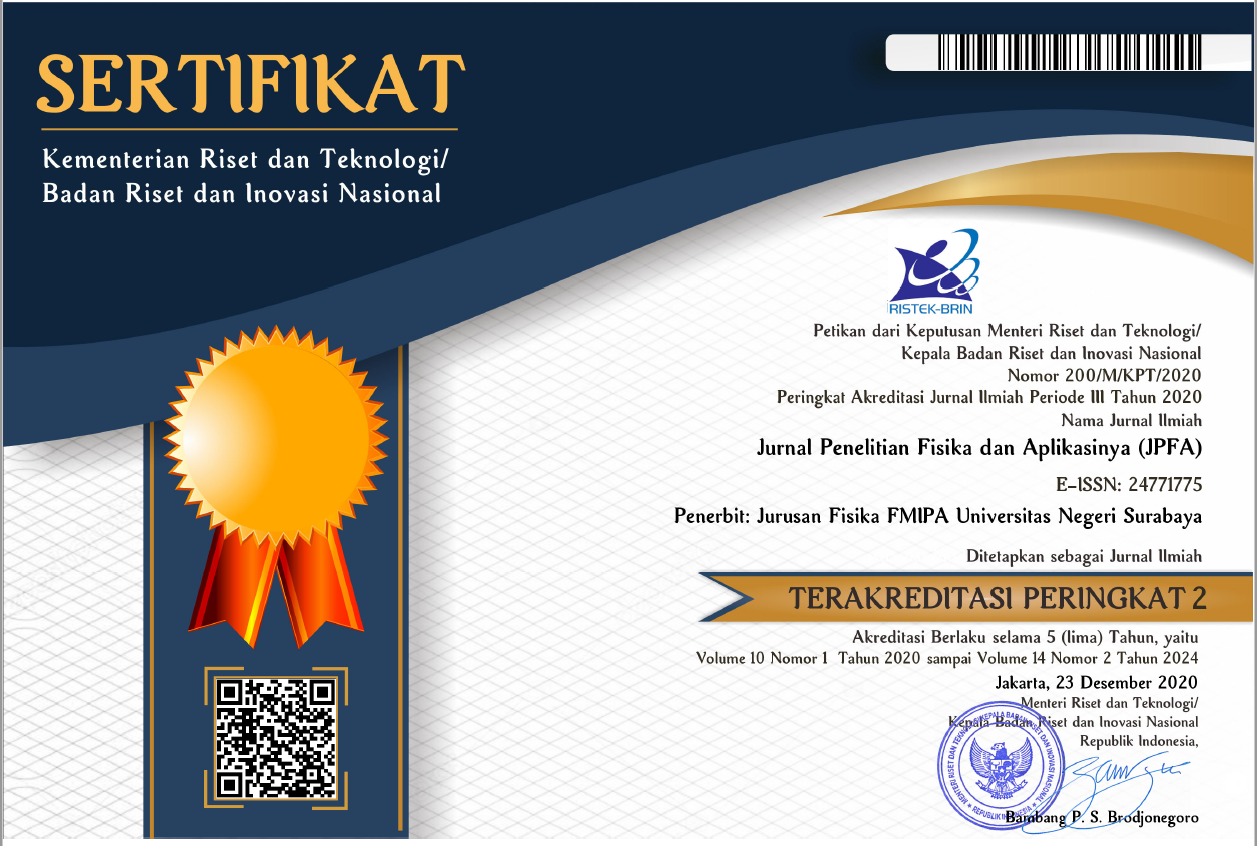Enhanced Performance of Solid Polymer Electrolyte Separator Lithium Battery with Cellulose Acetate From Empty Palm Fruit Bunch Coated Al2O3-Polyacrylic Acid
DOI:
https://doi.org/10.26740/jpfa.v13n2.p160-173Keywords:
Solid Polymer Electrolyte, Lithium Battery Efficiency, Cellulose Acetate, Empty Palm Fruit Bunch, Al2O3-Polyacrylic AcidAbstract
As lithium battery technology improves, it becomes more important to have solid polymer electrolyte dividers that work better. The objective of this study is to enhance the efficiency of solid polymer electrolyte separators in lithium batteries. This research aims to expand the limits of innovation in hybrid separator development by utilizing empty palm fruit bunches (OPFEB) as a plentiful source of cellulose acetate. This approach enhances ion transfer by increasing the number of pores in the separator. However, there are challenges to achieving the desired levels of optimal ionic conductivity. In order to address these constraints, this study presents a novel Al2O3-PAA inert ceramic oxide coating treatment that is applied to the separator by a spin coating technique. An electron microscope was utilized to observe the pore structure of the separator. Additionally, the separator underwent physical, mechanical, thermal, and cyclic voltammetry tests. The findings of this research indicate a significant increase in the physical properties, particularly the porosity and mechanical strength. The thermal shrinkage of the Al2O3-PAA coated separator is below 10% when exposed to a temperature of 140 oC for 30 minutes. The Cyclic Voltammetry test results demonstrate a pronounced loop curve, indicating an improvement in the ionic conductivity of the Al2O3-PAA coated separator. The findings of this study provide a method to enhance the efficiency of separator performance at high temperatures while maintaining safety and long battery life.
References
Lu M, Zhang X, Ji J, Xu X, and Zhang Y. Research Progress on Power Battery Cooling Technology for Electric Vehicles. Journal of Energy Storage. 2020; 27: 101155. DOI: https://doi.org/10.1016/j.est.2019.101155.
Sheikholeslami M. Analyzing Melting Process of Paraffin Through the Heat Storage with Honeycomb Configuration Utilizing Nanoparticles. Journal of Energy Storage. 2022; 52: 104954. DOI: https://doi.org/10.1016/j.est.2022.104954.
Gao C, Li X, Wei G, Wang S, Zhao X, and Kong F. Cellulose Acetate Propionate Incorporated PVDF-HFP Based Polymer Electrolyte Membrane for Lithium Batteries. Composites Communications. 2022; 33: 101226. DOI: https://doi.org/10.1016/j.coco.2022.101226.
Xu P, Zhang D, Shao Z, and Chen D. Cellulose Acetate-Based Separators Prepared by a Reversible Acetylation Process for High-Performance Lithium-Ion Batteries. Journal of Applied Polymer Science. 2021; 138(30): 50738. DOI: https://doi.org/10.1002/app.50738.
Vatanpour V et al. Cellulose Acetate in Fabrication of Polymeric Membranes: A Review. Chemosphere. 2022; 295: 1333914. DOI: https://doi.org/10.1016/j.chemosphere.2022.133914.
Chen H et al. Cellulose-Based Separators for Lithium Batteries: Source, Preparation and Performance. Chemical Engineering Journal. 2023; 471: 144593. DOI: https://doi.org/10.1016/j.cej.2023.144593.
Zhang T, Wang X, Liang J, Chen Q, and Huang J. Environmentally Friendly Separators Based on Cellulose Diacetate-Based Crosslinked Networks for Lithium-Ion Batteries. Polymer. 2024; 290: 126564. DOI: https://doi.org/10.1016/j.polymer.2023.126564.
Serra JP et al. Sustainable Lithium-Ion Battery Separators Based on Cellulose and Soy Protein Membranes. Electrochimica Acta. 2023; 462: 142746. DOI: https://doi.org/10.1016/j.electacta.2023.142746.
Pramono E et al. Cellulose Derived from Oil Palm Empty Fruit Bunches as Filler on Polyvinylidene Fluoride Based Membrane for Water Containing Humic Acid Treatment. Groundwater for Sustainable Development. 2022; 17: 100744. DOI: https://doi.org/10.1016/j.gsd.2022.100744.
Sikder MBH et al. Enzymatic Cellulose Nanocrystal Production from Pretreated Palm Oil Empty Fruit Bunch Fibers. Materials Today: Proceeding. 2023; In Press. DOI: https://doi.org/10.1016/j.matpr.2023.10.115.
Yanilmaz M. Cellulose based Hybrid Separators for High Performance Li-ion Batteries. European Journal of Science and Technology. 2021; 2021(28): 184-187. DOI: https://doi.org/10.31590/ejosat.994727.
Yu J, Dong N, Liu B, Tian G, Qi S, and Wu D. A Newly-Developed Heat-Resistance Polyimide Microsphere Coating to Enhance the Thermal Stability of Commercial Polyolefin Separators for Advanced Lithium-Ion Battery. Chemical Engineering Journal. 2022; 442: 136314. DOI: https://doi.org/10.1016/j.cej.2022.136314.
Wei Z, Zhang N, Feng T, Wu F, Zhao T, and Chen R. A Copolymer Microspheres-Coated Separator to Enhance Thermal Stability of Lithium-Sulfur Batteries. Chemical Engineering Journal. 2022; 430: 132678. DOI: https://doi.org/10.1016/j.cej.2021.132678.
Parikh D et al. Al2O3/TiO2 Coated Separators: Roll-To-Roll Processing and Implications for Improved Battery Safety and Performance. Journal of Power Sources. 2021; 507: 230259. DOI: https://doi.org/10.1016/j.jpowsour.2021.230259.
Cheng C, Liu H, Ouyang C, Hu N, Zha G, and Hou H. A High-Temperature Stable Composite Polyurethane Separator Coated Al2O3 Particles for Lithium Ion Battery. Composites Communications. 2022; 33: 101217. DOI: https://doi.org/10.1016/j.coco.2022.101217.
Kolm P, Behmer M, Kargl P, and Breitfuss C. Influence of Electrolyte Presence on The Vibration Behavior of a Li-Ion Pouch Cell and On the Mechanical Characteristics of Its Incorporated Al2O3-Coated Polyolefin Separator. Journal of Energy Storage. 2022; 51: 104249. DOI: https://doi.org/10.1016/j.est.2022.104249.
Firdous N and Janjua NK. CoPtx/?-Al2O3 Bimetallic Nanoalloys as Promising Catalysts for Hydrazine Electrooxidation. Heliyon. 2019; 5(3): E01380. DOI: https://doi.org/10.1016/j.heliyon.2019.e01380.
Thang AQ et al. Partially Neutralized PAA as an Efficient Binder for Aqueous Ceramic-Coated Separators for Lithium-Ion Batteries. Chemistry As Asian Journal. 2023; 18(18): e202300538. DOI: https://doi.org/10.1002/asia.202300538.
Zheng Z et al. An Efficient PDA/Al2O3 Nanosheets Reinforced Ultra-Thin ZrO2 Coating with Attractive Anti-Corrosion and Deuterium Resistance Property. Chemical Engineering Journal. 2022; 450: 138307. DOI: https://doi.org/10.1016/j.cej.2022.138307.
Chatterjee D et al. Electrochemical Performance of Melt Impregnated Lithium Sulphur Rechargeable Cell: Effect of Crosslinked Water Soluble PAA Binder. Materials Chemistry and Physics. 2024; 312: 128583. DOI: https://doi.org/10.1016/j.matchemphys.2023.128583.
He J, Das C, Yang F, and Maibach J. Crosslinked Poly(Acrylic Acid) Enhances Adhesion and Electrochemical Performance of Si Anodes in Li-Ion Batteries. Electrochimica Acta. 2022; 411: 140038. DOI: https://doi.org/10.1016/j.electacta.2022.140038.
Ginting D, Na Duma T, Rahmadani N, Suryani Y, and Haryanti R. Potential of Cellulose Acetat Separator of Empty Palm Oil Fruit Bunches and Polyvinylidene Fluoride for Energy Storage Applications. POSITRON. 2023; 13(1): 51-59. DOI: https://doi.org/10.26418/positron.v13i1.63784.
Ajayi SM et al. Hydrophobic Modification of Cellulose from Oil Palm Empty Fruit Bunch: Characterization and Application in Pickering Emulsions Stabilization. Carbohydrate Polymer Technologies and Applications. 2023; 5: 100282. DOI: https://doi.org/10.1016/j.carpta.2023.100282.
Saiful, Hasima S, Kamila N, and Rahmi. Cellulose Acetate from Palm Oil Bunch Waste for Forward Osmosis Membrane in Desalination of Brackish Water. Results in Engineering. 2022; 15: 100611. DOI: https://doi.org/10.1016/j.rineng.2022.100611.
Choi SH, Kang HJ, Ryu EN, and Lee KP. Electrochemical Properties of Polyolefin Nonwoven Fabric Modified with Carboxylic Acid Group for Battery Separator. Radiation Physics and Chemistry. 2001; 60(4-5): 495-502. DOI: https://doi.org/10.1016/S0969-806X(00)00396-0.
Jang J, Oh J, Jeong H, Kang W, and Jo C. A Review of Functional Separators for Lithium Metal Battery Applications. Materials. 2020; 13(20): 4625. DOI: https://doi.org/10.3390/ma13204625.
Shi K et al. Solid-State Polymer Electrolytes with Polypropylene Separator-Reinforced Sandwich Structure for Room-Temperature Lithium Ion Batteries. Journal of Membrane Science. 2021; 638: 119713. DOI: https://doi.org/10.1016/j.memsci.2021.119713.
Chen Z, Ma D, Feng F, and Wang J. A Salt-Free Poly(Acrylic Acid) Hydrogel Electrolyte with Self-Released Ions For Quasi-Solid-State Electrochromic Devices. Solar Energy Materials and Solar Cells. 2024; 266: 112644. DOI: https://doi.org/10.1016/j.solmat.2023.112644.
Tkachenko LI et al. Electrochemical Behavior of Polydiphenylamine-2-Carboxylic Acid and Its Hybrid Nanocomposites with Single-Walled Carbon Nanotubes on Anodized Graphite Foil in Lithium Aprotic Electrolyte. Reactive and Functional Polymers. 2022; 173: 105225. DOI: https://doi.org/10.1016/j.reactfunctpolym.2022.105225.
He J, Das C, Yang F, and Maibach J. Crosslinked Poly(Acrylic Acid) Enhances Adhesion and Electrochemical Performance of Si Anodes in Li-ion Batteries. Electrochimica Acta. 2022; 411: 140038. DOI: https://doi.org/10.1016/j.electacta.2022.140038.
Serhan M et al. Total Iron Measurement in Human Serum with a Smartphone. AIChE Annual Meeting, Conference Proceedings. Orlando: American Institute of Chemical Engineers; 2019. Available from: https://asu.elsevierpure.com/en/publications/total-iron-measurement-in-human-serum-with-a-smartphone.
Downloads
Published
How to Cite
Issue
Section
License
Copyright (c) 2023 Jurnal Penelitian Fisika dan Aplikasinya (JPFA)

This work is licensed under a Creative Commons Attribution-NonCommercial 4.0 International License.
Author(s) who wish to publish with this journal should agree to the following terms:
- Author(s) retain copyright and grant the journal right of first publication with the work simultaneously licensed under a Creative Commons Attribution-Non Commercial 4.0 License (CC BY-NC) that allows others to share the work with an acknowledgement of the work's authorship and initial publication in this journal for noncommercial purposes.
- Author(s) are able to enter into separate, additional contractual arrangements for the non-exclusive distribution of the journal's published version of the work (e.g., post it to an institutional repository or publish it in a book), with an acknowledgement of its initial publication in this journal.
The publisher publish and distribute the Article with the copyright notice to the JPFA with the article license CC-BY-NC 4.0.
 Abstract views: 479
,
Abstract views: 479
, PDF Downloads: 366
PDF Downloads: 366








